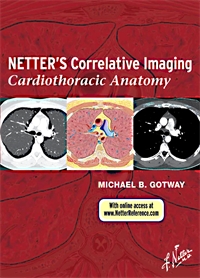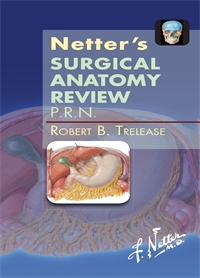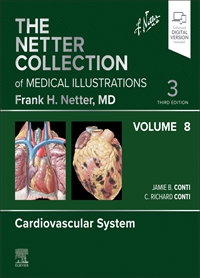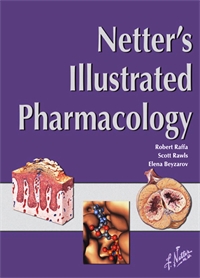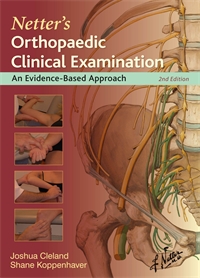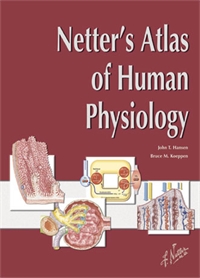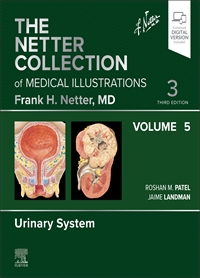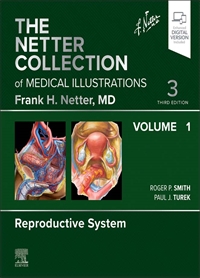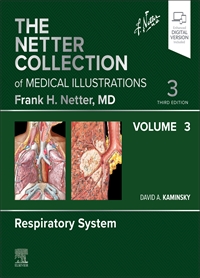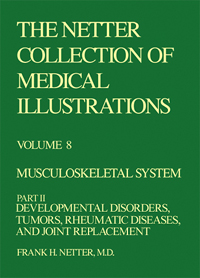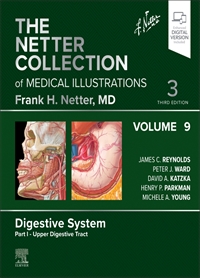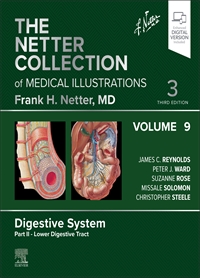The Netter Presenter: Pharmacology Collection
This product is no longer available, but individual images or image sets may be purchased
Author: Robert B. Raffa, PhD
ISBN: 9781933247134
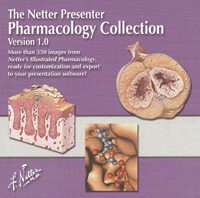
- Page 1.01: Eliminate External and Internal Threats
- Page 1.01: Eliminate External and Internal Threats
- Page 1.02: Replenish Or Neutralize Endogenous Chemicals
- Page 1.03: Modulate Physiologic Processes
- Page 1.04: Synaptic Transmission: Chemical Synaptic Transmission
- Page 1.05: Synaptic Transmission: Morphology of Synapses
- Page 1.06: Receptors and Signaling
- Page 1.07: Receptor Subytpes
- Page 1.08: Agonists
- Page 1.09: Antagonists
- Page 1.1: Stereochemistry and 3-Dimensional Fit
- Page 1.11: Receptor-Effector Coupling
- Page 1.12: Signal Transduction and Cross Talk
- Page 1.13: Second-Messenger Pathways
- Page 1.14: Ligand-Gated Ion Channels
- Page 1.15: G Protein-Coupled Receptors
- Page 1.16: TRK Receptor
- Page 1.17: Nuclear Receptors
- Page 1.18: Up-Regulation and Down-Regulation of Receptors
- Page 1.19: Dose-Reponse Curves
- Page 1.2: Potency
- Page 1.21: Efficacy
- Page 1.22: Inverse Agonists
- Page 1.23: Antagonists: Surmountable (Reversible) and Nonsurmountable (Irreversible)
- Page 1.24: Routes of Administration
- Page 1.25: First-Pass Effect
- Page 1.26: The Cell Membrane
- Page 1.27: Distribution
- Page 1.28: Barriers: Circulation In Placenta
- Page 1.29: Liver Structure: Schema
- Page 1.3: Cytochrome P-450 (CYP450) Enzymes
- Page 1.31: Metabolic Enzyme Induction and Inhibition
- Page 1.32: Intrarenal Arteries
- Page 2.01: Neuronal Cell Types
- Page 2.03: Peripheral Nervous System
- Page 2.04: Neuromuscular Transmission
- Page 2.05: Nicotinic Acetylcholine Receptor
- Page 2.06: Physiology of Neuromuscular Junction
- Page 2.08: Mechanism of Action of Acetylcholinesterase Inhibitors
- Page 2.09: Neuromuscular Blocking Agents: Nondepolarizing and Depolarizing
- Page 2.1: Autonomic Nervous System: Schema
- Page 2.11: Neural and Neuroendocrine Role In the Fight-Or-Flight Response
- Page 2.12: Autonomic Nervous System
- Page 2.13: Example of Cholinergic and Adrenergic Drug Treatment: Glaucoma
- Page 2.14: Cholinergic Receptors
- Page 2.15: Cholinergic Drugs
- Page 2.16: Example of Cholinergic Drug Treatment: Myasthenia Gravis
- Page 2.17: Adrenergic Receptors
- Page 2.18: Adrenergic Drugs
- Page 2.2: Drug Side Effects
- Page 3.01: Development of the Nervous System
- Page 3.02: Circulation of Cerebrospinal Fluid
- Page 3.02: Circulation of Cerebrospinal Fluid
- Page 3.03: Functional Correlations and Visualization of Brain Structures
- Page 3.04: Neuronal Resting Potential
- Page 3.05: Spatial and Temporal Summation
- Page 3.06: Central Nervous System Neurotransmitters, Receptors, and Drug Targets
- Page 3.07: GABAA Receptor Complex and Sedative-Hypnotic Drugs
- Page 3.08: Clinical Anxiety
- Page 3.09: Anxiolytic Agents
- Page 3.1: Causes of Seizures and Their Treatment
- Page 3.11: Epilepsy: Generalized and Status Epilepticus
- Page 3.12: Epilepsy: Partial and Absence Seizures
- Page 3.12: Epilepsy: Partial and Absence Seizures
- Page 3.13: Clinical Depression
- Page 3.14: Antidepressants: Mechanisms of Action
- Page 3.15: Bipolar Disorder and Compulsive Behavior
- Page 3.16: Psychosis and Dopamine Pathways
- Page 3.17: Basal Nuclei (Ganglia)
- Page 3.17: Motor Tracts, Basal Ganglia, and Dopamine Pathways
- Page 3.18: Parkinsonism: Symptoms and Defect
- Page 3.19: Parkinsonism: Levodopa, Carbidopa, and Other Drugs
- Page 3.2: Huntington Disease and Tourette Syndrome
- Page 3.21: Alzheimer Disease: Symptoms, Course, and Patholog
- Page 3.22: Alzheimer Disease: Cholinergic Involvement and Drugs
- Page 3.22: Alzheimer Disease: Cholinergic Involvement and Drugs
- Page 3.23: Stroke: Symptoms and Drug Treatmtent
- Page 3.24: Motor Neurons and Drugs
- Page 3.25: Pain Pathways
- Page 3.26: Local Anesthetics: Spinal Afferents and Local Anesthetic Mechanisms of Action
- Page 3.27: General Anesthetics: Properties
- Page 3.28: Opioids: Endogenous Opioid Pathway
- Page 3.29: Opioids: Receptor - Transduction Mechanisms
- Page 3.3: Nonopioids: NSAIDs, Selective Cyclooxygenase-2 Inhibitors, and Acetaminophen
- Page 3.31: Sumatriptans and Reuptake Inhibitors
- Page 4.01: Cardiovascular Function: Anatomy
- Page 4.02: Cardiovascular Function: Definition of Terms and Regulations
- Page 4.03: Role of Catecholamines In Heart Function
- Page 4.04: Sympathetic and Parasympathetic Regulation of Heart Function
- Page 4.05: Synthesis and Storage of Catecholamines
- Page 4.06: Regulation of Norepinephrine Release
- Page 4.07: Inactivation of Norepinephrine
- Page 4.08: Hypercholesterolemia: Causes
- Page 4.09: Hypercholesterolemia: Pharmacologic Therapy
- Page 4.1: Angina: Overview
- Page 4.11: Nitrates for Angina Treatment: Classes, Administration Routes, Pharmacology, and Adverse Effects
- Page 4.12: Nitroglycerin in Angina Treatment
- Page 4.13: Nitroglycerin: Mechanism of Action
- Page 4.14: Calcium Channel Antagonists
- Page 4.16: Heart Failure Overview
- Page 4.17: Heart Failure: Treatment
- Page 4.18: Heart Failure Treatment: _-adrenergic Stimulators and Blockers
- Page 4.19: Heart Failure Treatment: Cardiac Glycosides
- Page 4.2: Cardiac Arrhythmias: General
- Page 4.2: Cardiac Arrhythmias: General
- Page 4.22: Cardiac Arrhythmias: Drug Classification
- Page 4.23: Hypertension Overview: Hypertension as Risk Factor for Cardiovascular Disease
- Page 4.24: Hypertension: Causes
- Page 4.25: Hypertension Treatment: Diuretics
- Page 4.26: Hypertension Treatment: Angiotensin Converting Enzyme Inhibitors
- Page 4.27: Hypertension Treatment: _ and _ Blockers
- Page 4.28: Hypertension Treatment: Minoxidil
- Page 4.29: Hypertension Treatment: Clonidine
- Page 4.3: Hypertension in Elderly Patients
- Page 4.31: Pheochromocytoma: Induced Hypertension
- Page 4.32: Hypertension in Cushing Synrome
- Page 4.33: Peripheral Vascular Disease
- Page 5.01: Regulation of Hypothalamic and Pituitary Hormones
- Page 5.01: Regulation of Anterior Pituitary Hormone Secretion
- Page 5.02: Hypopituitarism
- Page 5.03: Growth Hormone Deficiency and Treatment
- Page 5.04: Growth Hormone Excess (Acromegaly) and Treatment
- Page 5.05: Thyroid Gland: Anterior View
- Page 5.06: Thyroid Hormones: Synthesis, Release and Regulation
- Page 5.07: Hypothyroidism
- Page 5.08: Hypothyroidism: Treatment of Choice
- Page 5.09: Liothyronine and T4-T3 Combinations
- Page 5.1: Hyperthyroidism
- Page 5.11: Hyperthyroidism: Treatment
- Page 5.12: Thioamides
- Page 5.13: Thioamides: Adverse Effects
- Page 5.14: Radioative Iodine
- Page 5.15: Iodide
- Page 5.16: Arenergic Antagonists
- Page 5.17: Regulation of Adrenal Hormones
- Page 5.18: Mineralocorticoids and Glucocorticoids
- Page 5.19: Corticosteroids
- Page 5.2: Cushing Syndrome
- Page 5.21: Ketoconazole
- Page 5.22: Metyrapone
- Page 5.23: Aminoglutethimide
- Page 5.24: Addison Disease, or Primary Adrenal Insufficiency
- Page 5.25: The Pancreas and Insulin Production
- Page 5.26: Insulin Secretion
- Page 5.27: Lack of Insulin
- Page 5.28: Type 1 Diabetes Mellitus
- Page 5.29: Type 2 Diabetes Mellitus
- Page 5.3: Insulin Therapy
- Page 5.31: Reactions to Insulin: Hypoglycemia and Adipose Tissue Change
- Page 5.32: Sulfonylureas
- Page 5.33: Biguanides
- Page 5.34: Meglitinides
- Page 5.35: Alpha-Blucosidase Inhibitors
- Page 5.36: Thiazolidinediones
- Page 5.37: Thiazolidinediones: Clinical Rationale and Adverse Effects
- Page 6.01: Enteric Nervous System
- Page 6.02: Autonomic and Enteric Integration
- Page 6.03: Gastrointestinal Motility
- Page 6.03: Gastrointestinal Motility
- Page 6.04: Motility
- Page 6.05: Major Gastrointestinal Hormones
- Page 6.06: Gastric Secretion
- Page 6.07: Pancreas Secretion
- Page 6.08: Defecation
- Page 6.09: Digestion of Protein
- Page 6.1: Fat Digestion
- Page 6.11: Colonic Motility and Treatment of Diarrhea
- Page 6.12: Antidiarrheal Drugs and Their Adverse Effects
- Page 6.13: Causes of Constipation
- Page 6.14: Treatment of Constipation
- Page 6.15: Treatment of Irritable Bowel Syndrome
- Page 6.16: Giardiasis
- Page 6.17: Helicobacter Pylori Infection Overview
- Page 6.18: Treatment of Helicobacter Pylori Infection
- Page 6.19: Peptic Ulcer Treatment
- Page 6.2: Gastroesophageal Reflux Disease Overview
- Page 6.21: Gastroesophageal Reflux Disease Treatment
- Page 6.22: Acute Pancreatitis
- Page 6.22: Treatment of Pancreatitis
- Page 6.23: Pathologic Features of Gallstones
- Page 6.24: Pathogenesis of Gallstones
- Page 6.25: Liver Function
- Page 6.26: Bilirubin Production and Excretion
- Page 6.27: Nutritonal Liver Diseases
- Page 6.28: Ascites
- Page 6.28: Ascites
- Page 6.29: Physiology of Emesis
- Page 6.3: Antiemetics
- Page 7.01: Respiration Overview
- Page 7.02: Respiratory Diseases
- Page 7.03: Allergy
- Page 7.04: Leukocyte Function
- Page 7.05: Allergic Rhinitis
- Page 7.06: Introduction to Asthma
- Page 7.07: Extrinsic and Intrinsic Asthma
- Page 7.07: Extrinsic and Intrinsic Asthma
- Page 7.08: Asthma Pharmacotherapy
- Page 7.09: Anti-IgE Antobodies
- Page 7.1: Mast Cell Degranulation Blockers
- Page 7.11: Bronchodilators
- Page 7.12: Methylxanthines
- Page 7.13: Methylxanthine: Adverse Effects
- Page 7.14: beta-Adrenergic Agonists
- Page 7.15: Nonselective beta-Adrenergic Agonists
- Page 7.16: Selective beta 2-Adrenergic Agonists
- Page 7.17: Antimuscarinic Antagonists
- Page 7.18: Corticosteroids
- Page 7.19: Corticosteriods: Clinical Uses
- Page 7.2: Corticosteriods: Adverse Effects
- Page 7.21: Leukotrienes
- Page 7.22: Leukotriene Antagonists
- Page 7.23: Cough
- Page 7.24: Cough Suppressants (Antitussive Agents)
- Page 7.25: Chronic Obstructive Pulmonary Disease
- Page 7.26: Emphysema
- Page 7.27: Emphysema: Causes
- Page 7.28: Inherited Emphysema
- Page 7.29: Chronic Bronchitis
- Page 7.3: COPD: General Treatment Measures
- Page 7.31: COPD: Specific Drug Treatments
- Page 7.32: Restrictive Lung Disease
- Page 7.33: Pneumonia
- Page 7.34: Viral Pneumonia
- Page 7.34: Viral Pneumonia
- Page 7.35: Bacterial Pneumonia
- Page 8.01: Organization of the Reproductive System
- Page 8.02: Regulation of Estrogen and Testosterone
- Page 8.03: Events of the Normal Menstrual Cycle
- Page 8.04: Combination Oral Contraceptives
- Page 8.05: Major Adverse Effects of Combination Oral Contraceptives
- Page 8.06: Estrogen and Coagulation
- Page 8.07: Progestin-Only Contraceptives
- Page 8.08: The Morning-After Pill
- Page 8.09: The Abortion Pill
- Page 8.1: Endometriosis
- Page 8.11: Danazol
- Page 8.12: Gonadotropin-Releasing Hormone Agonists, Combination Oral Contraceptives, and Progestin
- Page 8.13: Estrogen Decline
- Page 8.14: Vasomotor Symptoms
- Page 8.15: Genitourinary Atrophy
- Page 8.16: Osteoporosis and Estrogen
- Page 8.17: Role of Progestins In Hormone Replacement Therapy
- Page 8.18: Route of Hormone Administration
- Page 8.19: General Adverse Effects
- Page 8.2: Cardiovascular and Neurologic Risks
- Page 8.21: Cancer Risks
- Page 8.22: Selective Estrogen Receptor Modulators
- Page 8.23: Antiestrogens
- Page 8.24: Hypogonadism
- Page 8.25: Hypogonadism Treatment and Adverse Effects
- Page 9.01: Anterior Surface of Right Kidney
- Page 9.02: Anatomy of the Kidney: The Nephron
- Page 9.03: Blood Vessels in Parenchyma of Kidney
- Page 9.04: Glomerular Structure
- Page 9.05: Glomerular Filtration
- Page 9.06: Tubular Segments
- Page 9.07: Ion and Water Reabsorption
- Page 9.08: Bicarbonate Reabsorption
- Page 9.09: Potassium Excretion
- Page 9.1: ADH Secretion and Action
- Page 9.11: Renin-Angiotensin-Aldosterone System
- Page 9.12: Response to Volume Expansion
- Page 9.13: Mercurial Diuretics
- Page 9.14: Carbonic Anhydrase Inhibitors
- Page 9.15: Thiazide Diuretics
- Page 9.16: Potassium-Sparing Agents
- Page 9.17: Loop (High-Ceiling) Diuretics
- Page 9.18: Osmotic Agents
- Page 9.19: Summary of Therapeutics
- Page 9.2: Urinary Incontinence
- Page 9.21: Urinary Tract Calculi (Kidney Stones)
- Page 9.22: Effect of Renal Insufficiency On Drug Action
- Page 9.23: Effect of Hemodialysis on Drug Action
- Page 10.01: Classification of Antibiotics
- Page 10.04: Mechanisms of Resistance
- Page 10.05: Examples of Resistance
- Page 10.06: Natural Penicillins: Penicillin G and Penicillin V
- Page 10.07: Aminopenicillins: Amixicillin and Ampicillin
- Page 10.08: Antipseudomonal Penicillins: Carbenicillin, Piperacillin, and Ticarcillin
- Page 10.09: Beta-Lactamase Inhibitors
- Page 10.1: Beta Lactamase-Resistant Penicillins: Cloxacillin, Dicloxacillin, Oxacillin, and Nafcillin
- Page 10.11: Adverse Effects of Penicillins
- Page 10.12: Cephalosporins
- Page 10.13: Carbapenems: Imipenems: Cilastatin, Ertapenem, and Meropenem
- Page 10.14: Monobactams: Aztreonam
- Page 10.15: Vancomycin
- Page 10.16: Vancomycin Treatment Difficulties: Resistance and Adverse Effects
- Page 10.17: Tetracyclines
- Page 10.18: Aminoglycosides
- Page 10.19: Macrolides: Erythromycin, Azithromycin, and Clarithromycin
- Page 10.2: Clindamycin
- Page 10.21: Quinolones
- Page 10.22: New-Generation Quinolones
- Page 10.24: Linezolid
- Page 10.25: Sulfonamides
- Page 10.26: Nature of Fungal Infections and Therapy
- Page 10.27: Amphotericin B
- Page 10.28: Azole Antifungal Agents and Other Antifungal Agents
- Page 10.29: Nature of Viral Infections
- Page 10.3: Herpesviruses
- Page 10.31: Lesions of Herpes Simplex
- Page 10.32: Ganciclovir
- Page 10.33: Influenza and Its Treatment
- Page 10.34: HIV Infection
- Page 10.35: Nucleoside Reverse Transcriptase Inhibitors (NRTIs) and Non-NRTIs
- Page 10.36: Protease Inhibitors
- Page 10.37: Other Antiretrovial Agents for AIDS: Tenofovir and Enfuvirtide
- Page 11.01: Cell Cycle
- Page 11.02: Combination Chemotherapy
- Page 11.03: Adverse Effects of Chemotherapy
- Page 11.04: Folate Analogs: Methotrexate
- Page 11.05: Purine Analogs: Mercaptopurine and Thioguanine
- Page 11.06: Pyrimidine Analogs: 5-Fluoruoracil
- Page 11.07: Pyrimidine Analogs: Capecitabine
- Page 11.08: Pyrimidine Analogs: Cytarabine and Fludarabine
- Page 11.09: Pyrimidine Analogs: Gemcitabin
- Page 11.11: Nitrogen Mustards: Mecholorthamine and Melphalan
- Page 11.12: Cyclophosphamide and Ifosfamide
- Page 11.13: Nitrosoureas: Carmustine and Lomustin
- Page 11.14: Platinum Compounds: Cisplatin, Carboplatin, and Oxaliplatin
- Page 11.15: Vinca Alkaloids: Vincrisitne, Vinblastine, and Vinorelbine
- Page 11.16: Taxanes
- Page 11.17: Anthracyclines: Doxorubicin and Daunorubicin
- Page 11.18: Estrogen Antagonists: Tamoxifen and Toremifene
- Page 11.19: Aromatase Inhibitors: Anastrozole, Letrozole, and Exemestane
- Page 11.2: Gonadotropin-Releasing Hormone Analogs: Leuprolide and Goserelin
- Page 11.21: Antiandrogens: Flutamide, Bicalutamide, and Nilutamide
- Page 11.22: Unconjugated Antibodies: Trastuzumab, Alemtuzumab, and Rituximab
- Page 11.23: Conjugated Antibodies: Ibritumomab Tiuxetan and Tositumomab and Iodine I 131 Tositumomab
- Page 11.24: Imatinib Mesylate
- Page 11.25: Gefitinib
- Page 11.26: Bortezomib
- Page 12.01: Anatomy of the Skin
- Page 12.02: Alopecia
- Page 12.03: Bullous (Blister) Skin Diseases
- Page 12.05: Psoriasis
- Page 12.06: Scabies and Pediculosis
- Page 13.01: Deficiency of Vitamin A (Retinol) and Other Fat-Soluble Vitamins
- Page 13.02: Deficiency of Thiamine (B1) and Other B Vitamins
- Page 13.03: Niacin Or Nicotinic Acid Deficiency (Pellagra)
- Page 13.04: Vitamin C Deficiency (Scurvy)
- Page 13.05: Fat-Soluable Vitamin-Drug Interactions
- Page 13.06: Water-Soluable Vitamin-Drug Interactions
- Page 14.01: Allergic Reactions to Drugs
- Page 14.02: Type 1 (Acute, Anaphylactic) Reactions
- Page 14.03: Type 2 (Cytotoxic, Autoimmune) Reactions
- Page 14.04: Type 3 (Immune Complex, Serum Sickness, Arthus) Reactions
- Page 14.05: Type 4 (Cell-Mediated, Delayed / Hypersensitivity, Contact Dermatitis) Reactions
- Page 14.06: Brain Reward Circuit
- Page 14.07: Ethanol: Deleterious Effects
- Page 14.08: Ethanol Abuse: Treatment
- Page 14.09: Withdrawal: Opioids, Benzodiazepines, and Barbiturates
- Page 14.09: Withdrawal: Opioids, Benzodiazepines, and Barbiturates
- Page 14.1: Sympathomimetic Drugs
- Page 14.11: Cholinergic Drugs
- Page 14.12: Anticholinergic Drugs
- Page 14.13: Serotonergics
- Page 14.14: Opioids
- Page 14.15: Over-the-Counter Products
- Page 14.16: Management of Poisoning and Overdose

